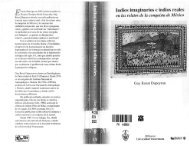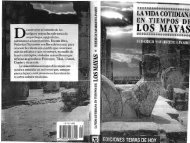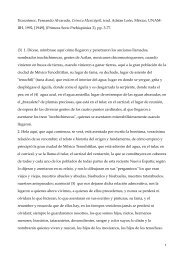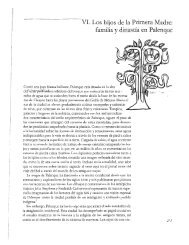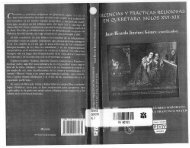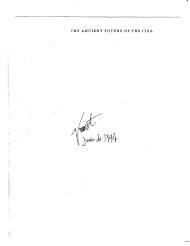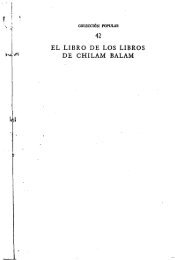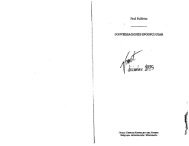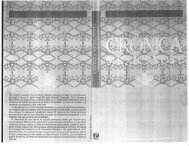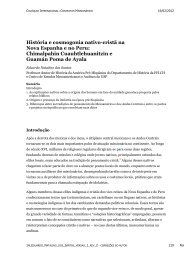HEAVEN BORN MERIDA AND ITS DESTINY - Histomesoamericana
HEAVEN BORN MERIDA AND ITS DESTINY - Histomesoamericana
HEAVEN BORN MERIDA AND ITS DESTINY - Histomesoamericana
You also want an ePaper? Increase the reach of your titles
YUMPU automatically turns print PDFs into web optimized ePapers that Google loves.
INTRODUCTION<br />
root dictionary of about four thousand entries. I have translated primarily<br />
from these two instruments, consulting other dictionaries when necessary<br />
(see the bibliography in Barrera 1980).<br />
The lexical problems of the Books of Chilam Balam are severe, and it<br />
would be foolhardy to claim to have solved them all. I am satisfied that I<br />
have solved some of them, and I believe that some of these solutions are<br />
consequential beyond the minutiae of specific etymologies. Four examples<br />
will illustrate this point.<br />
1. Ix. In my notes this can be a particle meaning 'she who, little, too,<br />
shoo!'; a noun for 'scales', the day name 'jaguar', or something to do with<br />
'chalk'; or a verb for 'spoil' or something like 'lie in'. Previous translators<br />
have opted for the first two alternatives, preferring to read ix as a<br />
feminine marker or, failing that, as a diminutive. I find that the form<br />
can much more frequently be sensibly read as 'and'. In the nineteenthcentury<br />
dictionaries (e.g., Brasseur 1872), it is frequently reduced to x and<br />
often appears in compounds with sentence-initial elements [baalx, macx,<br />
hex, etc.). I read these as 'and what', 'and who', 'and that'.<br />
This form first occurs in the Chumayel text in "The Third Chronicle"<br />
(tenth century): la ix u katunil cime i 'and that was the katun count of<br />
the death' (lines 295-296). Then we read yx ma pic tz'ul u kaba 'and Foreigners<br />
without Skirts was their name' (line 309). Or again: buluc ahau u<br />
katunil ti ix hop'i xpnoil lae '11 Ahau was also the katun period that began<br />
Christianity' (lines 360-362).<br />
Ix is frequently encountered as an element in place-names, earliest (and<br />
still preconquest) at t ix meuac (line 910). I assume that the implication<br />
here is diminutive: no important town or city is so named.<br />
It may or may not be significant that it is not until after the conquest<br />
that we encounter an ix that might mean 'she', and even then the usage is<br />
extremely rare. Of the seventeen goddesses listed by Barrera (1948: 83), I<br />
am prepared to concede one: Ix Tab, goddess of the hanged. I believe all<br />
the others to be phrases introduced by 'and'. I am also willing to grant the<br />
plausibility of Ix Chel, goddess of the rainbow, who didn't make Barrera's<br />
list for some reason, and there can be no doubt about the acceptability of<br />
ix mehen 'daughter' or ix ahau 'queen'.<br />
2. May. This is an even more consequential lexical problem, since it<br />
goes to the heart of the whole organization and meaning of the Books of<br />
Chilam Balam. This noun may signify 'dust, hoof, mild, example, wink',<br />
but by far the most frequent implication is 'cycle', specifically the cycle<br />
of thirteen katuns. Previous translators have passed over the term because<br />
it does not seem to have made the dictionaries, but from the contexts in<br />
which it appears I believe its meaning to be unmistakable (Chumayel, line<br />
5315; Tizimin, lines 2121, 2914, 2942, 4879, 5067).<br />
Thus at differing dates Mayapan, Merida, Valladolid, and other cities are<br />
referred to as may cu 'seat of the cycle'. Landa (Tozzer 1941: 27) acknowledges<br />
the titles ahau can may 'rattlesnake of the cycle' and ah kin may<br />
'sun priest of the cycle' as references to the highest priesthood in Yucatan<br />
but without understanding their significance. This is the priest more<br />
commonly called the Jaguar [balam) or the Rattlesnake [ahau can), since<br />
his formal<br />
hold offici<br />
power, pre<br />
Spokesma<br />
Chilam B.<br />
The imi<br />
related us;<br />
heaven, zi<br />
the capita<br />
the Plaza |<br />
ligious cei<br />
first tree' '.<br />
is this last<br />
which wo<br />
of the (pec<br />
in 1752, it<br />
white spai<br />
The Ma<br />
lonial tim<br />
IS-katun<br />
of the Ma?<br />
in the Cla<br />
cycle as u<br />
larized by<br />
histories,<br />
in the nin<br />
3. Cong<br />
this expre<br />
congel) se<<br />
the letter<br />
syncretist:<br />
reference i<br />
colonial IV<br />
the nativii<br />
against th<<br />
The yea<br />
the 365-di<br />
known co!<br />
who rarely<br />
of a single<br />
Muluc, Ix,<br />
four. Thei<br />
beginning<br />
The day<br />
dar round<br />
Such a cy«<br />
sion kin t<br />
mayel and



